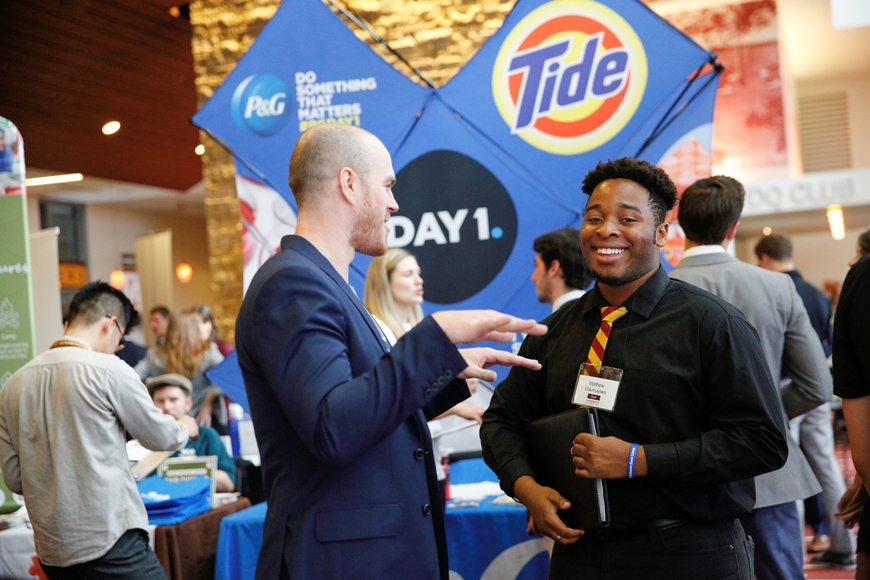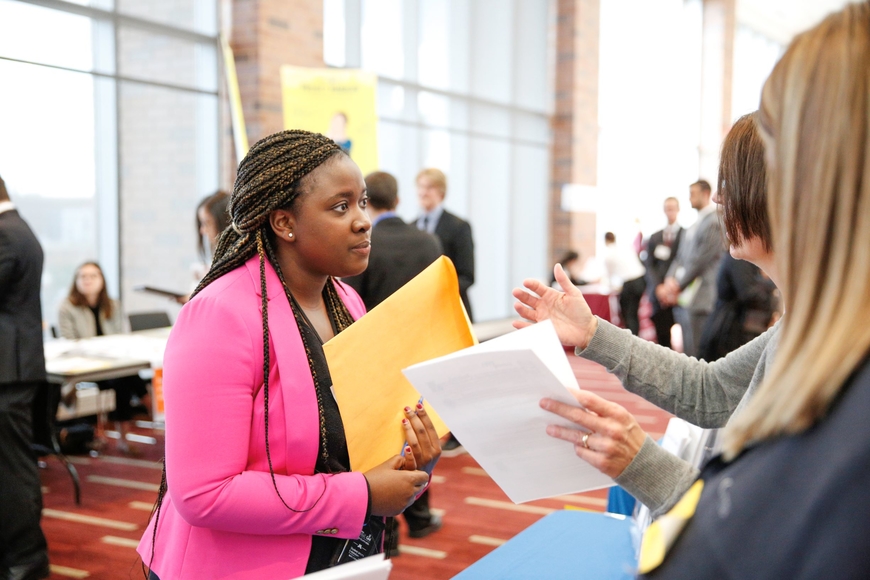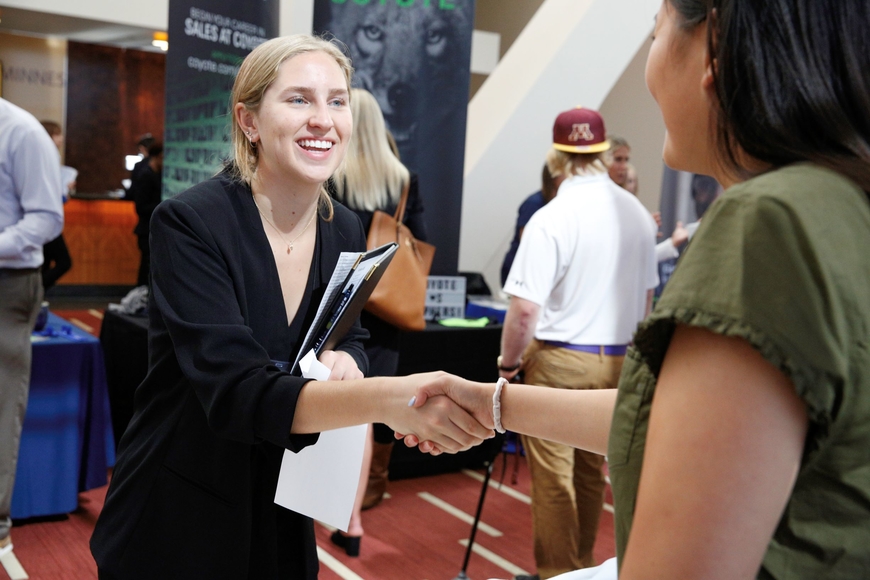Tips for Inclusive Recruiting



“Census data show professionals of color come to MSP from other parts of the U.S. at higher rates than white professionals yet choose to stay here much less often… Overall, the feedback told us people come for career opportunities, stay for family and leave because they feel the metro lacks diversity and cultural awareness. Digging deeper, key themes emerged that draw a more detailed and interconnected picture about challenges in and out of the workplace.”
(Source: Make It MSP)
CLA students are critical thinkers who actively engage diversity and aspire to make a meaningful difference after graduation in their communities, in the world, and in their careers. CLA students increasingly express a desire and hope to bring their authentic selves to an organization where they can make an impact by applying their education, core career competencies, and life experiences.
To connect with CLA students in an authentic and inclusive way that provides you with the broadest pool of talent, consider these tips and resources:
Strategies and Resources for Inclusive Recruiting
Consider the Whole Package
- The best candidates will bring diverse perspectives, experiences, and skills, not just a high GPA.
- Consider being flexible with requirements in order to attract a broad range of strong candidates.
- Evaluate minimum requirements.
We stand with the University of Minnesota and the Office for Equity and Diversity in calling for sustained, meaningful action and change. As career services, we are supporting students and employer partners in the quest to dismantle systems of oppression through equitable employment practices.
The University of Minnesota is committed to the policy that all persons shall have equal access to its programs, facilities, and employment without regard to race, color, creed, religion, national origin, gender, age, marital status, disability, public assistance status, veteran status, sexual orientation, or gender expression. View the full User Agreement here.
Share your organization's diversity, equity, and inclusion statement. Statements will be shared with students and the University community here.
Be Aware of Cultural Communication Styles
- A handshake upon greeting or eye contact while speaking may not be culturally appropriate for all students. Follow the communication cues of the students by offering a smile and a friendly greeting.
- Ask open-ended questions about students’ interests to get them engaged in conversation.
- Avoid acronyms or jargon unique to your organization.
Be Transparent
- Communicate your organization’s commitment to equity and diversity, such as stating your organization’s values, what affinity groups you have, and other related initiatives.
- Be open with students about the culture of your organization. Share information to help them assess whether your organization is a good match for them.
Develop Clear and Inclusive Job Descriptions
- Reflect your organization’s values around creating an inclusive work environment.
- Identify the specific ways employees can support inclusion efforts.
- Make special note of inclusive benefits (parental leave policies, partner benefits, etc.)
- View this sample position description.
Example Concerns Students May Have About Identity in the Job Search
- How do I disclose my identities in my job search?
- I’m worried my appearance may raise concerns to prospective employers (ex. hair color/style, piercings, tattoos, religious attire, gender expression, etc.). How do I decide whether to change my appearance for an upcoming interview?
- Should I list a certain organization on my resume that may “out” me (i.e. religious groups, political affiliations, LGBTQ organizations, etc.)?
- What should I do if I’m asked an illegal question during an interview?
- I do not shake hands for cultural reasons. What should I do at my interview?
- How do I identify whether a company or organization will be a good fit for me?
- I know I will need accommodations during my interview or on the job. How do I address this?
- I’m worried my background check may raise concerns. What should I do?
- How do I address citizenship status if I am unable to legally work in this country?
- How do I answer the question, “do you need a sponsor to work in the U.S.?”
- What are the legal protections for transgender individuals in the workplace in Minnesota?
- How can I research what health coverage benefits are available to me through a prospective employer?
- I have a gap on my resume because of a leave of absence for a mental health crisis. How can I manage this in my job search or address the impact it had on my GPA for graduate school?
- Where can I get help knowing how to best highlight my military service as being relevant to a position?
- I got a job offer and have heard that women often make less than men in the U.S. How do I make sure I am paid fairly?
- I am experiencing some changes in my family structure (i.e. marriage, pregnancy, children, adoption, death of a family member, changes in primary care status, etc.), and I am worried about how this could impact employer perceptions of my ability to effectively do my job. How do I navigate this?
Other Resources We Find Helpful
Training & Development
- BE MSP Workplace Toolkit—A free online course, produced by MakeIt. MSP (a Twin Cities workforce development organization), designed to help you and your organization spark conversations and build an inclusive culture in your workplace.
- Society for Human Resource Management (SHRM) guidelines on interview questions.
- Navigating Identity in the Workplace — a resource for students created by CLA Career Services.
- Fearless works with The BrandLab partners through four areas of programming to ensure that both the workplace and work produced are culturally competent, inclusive to diverse identities, and equitable.
- UMAA’s Addressing Systemic Racism webpage.
- OED Diversity Certificate Program for External Participants.
- Explore how major corporations have committed to racial equity using this tracker by Just Capital.
- Diversity & Inclusion: The Ultimate Guide for HR & Recruiting (from Handshake).
- Diversity, Equity, Inclusion and Social Justice Work in CLA.
- Information on bias and racism in resume review.
- Our job posting guide and tips for writing an inclusive job post.
- Diversity Recruitment Resources on our central website: http://career.umn.edu/employers.
Reading Corner
- From Handshake’s Blog — 3 Hiring Practices that Disadvantage Black Students: Learn how to address systemic challenges by modifying your qualified student search criteria.
- Career services is social justice work.
Hiring International Students
Consider hiring international students for your internships or entry-level positions — It’s quick, easy, and cost-free for at least 12 months post-graduation.
- Watch the “Hire and Recruit at the UMN: Diversify Your Workforce with International Candidates” webinar.
- Quick Look at Hiring International Students at the University of Minnesota.
International students from CLA will bring your organization:
- A comprehensive liberal arts education, with an emphasis on creative problem solving, analytical skills, entrepreneurial mindset, and effective communication.
- Experience in research, student organizations, mentorship, and leadership development.
- Multilingual capacity and experience succeeding in global work teams.
- The ability to adapt and function in ambiguous situations.
You can look at the process of hiring CLA international students through three lenses:
- Internships through Curricular Practical Training (CPT).
- Post-graduation jobs through Optional Practical Training (OPT).
- Beyond the Optional Practical Training (OPT) period.
Internships Through Curricular Practical Training (CPT)
- Students can work full-time during school breaks and/or part-time during school, as long as the work is related to the student’s major field of study. Students must have completed two semesters in the U.S. before becoming eligible for internships.
- Students are responsible for filing paperwork with the U of M and can be authorized to begin work within seven working days.
- As an employer, you need only present the student with an internship offer of employment—no government filings, no expense.
Post-Graduation Jobs Through Optional Practical Training (OPT)
- Students can work part-time or full-time in a position related to their major for at least 12 months after graduation.
- Students are responsible for filing paperwork with the UMN and may be eligible to begin work as early as immediately following graduation.
- Students who earned a degree in a STEM major (such as math, engineering, chemistry, or computer science), and who are working in a STEM-related position, are eligible for an additional 24 months of part-time or full-time work (for a total of 36 months), assuming the employer is or will become e-verified (called an OPT STEM extension).
- As an employer, you need only present the student with an offer of employment—no government filings, no expense.
Beyond the Optional Practical Training Period
Employers can sponsor international employees for longer-term work. The most common way is to apply for an H-1B. There are other visa possibilities, including permanent residence ("green card").
H-1B: No minimum duration, maximum is three years at a time. Renewable for up to six years. Costs range from $2,000-6,000. Permanent Residence: Also known as the green card. Expenses vary.
Learn more information from the UMN International Student and Scholar Services (ISSS).
Advisors in the International Student and Scholar Services (ISSS) office on the University of Minnesota-Twin Cities campus offer general advice to employers about work authorization options for UMN international students. For information about a specific student, the student must first sign a release form. Contact ISSS at isss@umn.edu or 612-626-7100 to learn more.
Legal Disclaimer
The information presented here is not intended as, and does not serve as legal advice; it is for informational purposes only and is not a substitute for professional legal advice. Content is subject to change. Employers are advised to consult an experienced U.S. immigration attorney for advice and further information.
Learn more information on regulations regarding the hiring of international students.